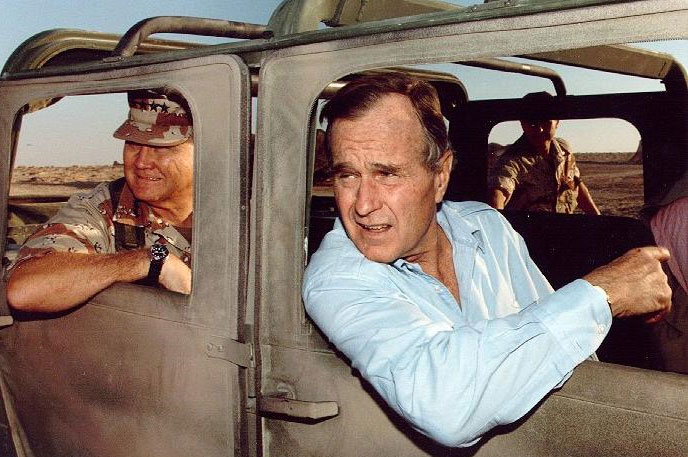
Source: P17706-15, George Bush Presidential Library and Museum

Source: P17706-15, George Bush Presidential Library and Museum
George H. W. Bush served as vice president during the Reagan Administration. He was elected as president in 1988 and served from 1989 to 1993. During the Bush administration, there were major events that shaped Bush’s foreign policy. The most dramatic change that Bush faced was the end of the Cold War in 1991. The Soviet Union crumbled, loosening the grip that it had on Eastern Europe and many other parts of the world.
While the spread of communism became less of a threat to democracy, there were new enemies emerging in the world. Read more about the global threats that shaped foreign policy during the Bush Administration.
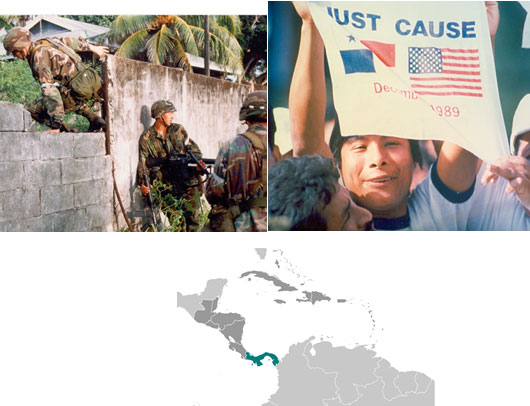
Source: Central America and Caribbean: Panama, The World Factbook, Over the wall and through the Breech, U.S. Army, Bueno America, U.S. Army
On December 20, 1989, Operation Just Cause was carried out in the Central American country of Panama. American troops invaded Panama to remove Manuel Noriega, a former ally of the American CIA who had become a corrupt military dictator, and reinstate the democratically elected government. Noriega was also charged with international drug trafficking.
The United States brought Noriega to trial in Miami where he was later convicted of converting the Panama Canal into a shipping point of drug trafficking for Columbia. In 1992, Noriega was sentenced to 30 years; he was extradited to France in 2010.
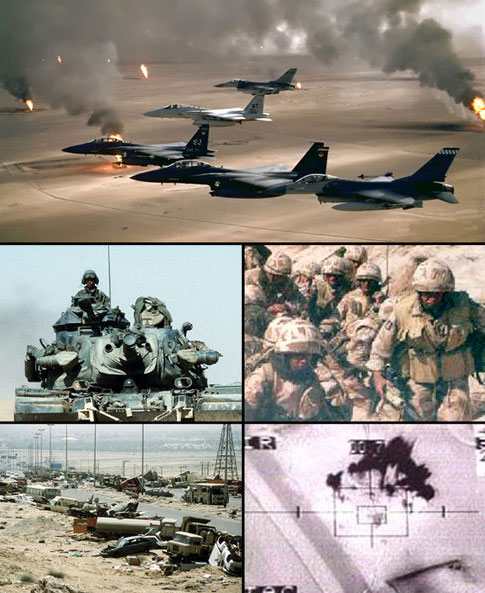
Source: Gulf War Photobox, Acdx, Wikimedia
The Bush Administration also faced a threat in the Middle East. Saddam Hussein, dictatorial ruler of Iraq, invaded the country of Kuwait in 1990. After ignoring demands from the United Nations to withdraw from Kuwait, United States-led forces initiated Operation Desert Storm, a military assault which signaled the beginning of the Persian Gulf War in 1991. The war lasted only 42 days with Iraqi troops eventually surrendering. Although this war was brief, it planted the seeds for U.S. political and military involvement for years to come.
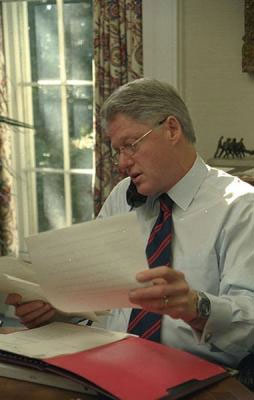
Source: President Clinton Multi-Tasking, The William J. Clinton Library
Foreign policy involving the Middle East became an important task for the presidency of Bill Clinton. In 1993, Clinton brokered the Oslo Peace Accords, a peace agreement between Israel and Palestine, which led to more open talks between the two nations. By the time Clinton left office, however, the peace process faltered and more Israeli-Palestinian violence had begun.
Read more about the agreement here: Oslo Peace Agreement
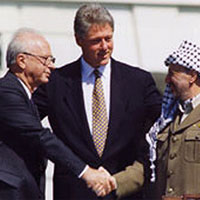
Source: Oslo, The Department of the State
In 1998, Iraqi leader Saddam Hussein refused to allow United Nations weapons inspectors to complete an inspection for prohibited weapons of mass destruction in Iraq. After continued refusal, Clinton ordered a military strike to attack any areas where possible chemical, nuclear, or biological weapons were being manufactured.
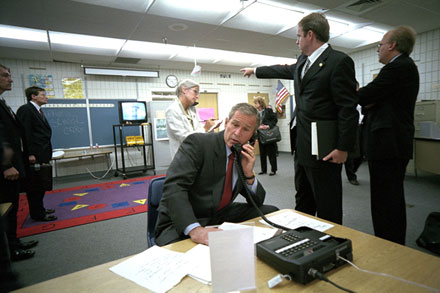
Source: P7058, George W. Bush Presidential Library and Museum
In 2001, George W. Bush became the 43rd president of the United States. Less than eight months after taking office, Bush encountered one of the most devastating events in U.S. history. On September 11, 2001, members of al Qaeda, an Islamic extremist group, hijacked four airplanes. The terrorists flew two of the planes into the Twin Towers of the World Trade Center in New York. They crashed another plane into the Pentagon near Washington, D.C. The fourth plane crashed in a field in Pennsylvania after the plane's passengers heroically struggled to overcome the terrorist hijackers.

Source: North face south tower after plane strike 911, Robert, Wikimedia
This terrorist attack, sometimes called 9/11, killed more than 2,900 civilians, police officers, and firefighters. This event was the deadliest terrorist attack on American soil in history. The exact reasons for the attack have not been uncovered, but it is alleged that the terrorists were acting out of retaliation for the United States’ involvement in issues concerning countries in the Middle East. Less than a month after the 9/11 attack, the United States launched a war against terrorists and their supporters in Afghanistan. The 9/11 attack led Bush to formulate a new department within his Cabinet, the Department of Homeland Security. This department was created to prevent and respond to terrorist attacks. Bush overhauled the military to defeat the newest type of terrorism.
In 2003, President Bush led the United States into a second war in Iraq. The United States and its allies invaded Iraq in Operation Iraqi Freedom, a mission to eliminate Saddam Hussein as the leader of Iraq and end his ability to create weapons of mass destruction. The mission lasted from March 2003 to May 2003, and Saddam Hussein was captured in December 2003. Although the combat mission had ended, the fighting in Iraq continued, and large numbers of U.S. troops remained in Iraq for more than eight years.
After President Barack Obama took office in 2009, he presided over the withdrawal of American troops from Iraq in 2011.
U.S. special forces won a victory over terrorism when they attacked and killed Osama bin Laden in 2011. Bin Laden was responsible for the 9/11 attacks and had eluded capture by the United States since 2001.
![]() Watch the video below of President Obama’s address to the nation following the death of Osama bin Laden.
Watch the video below of President Obama’s address to the nation following the death of Osama bin Laden.
Source: President Obama on Death of Osama Bin Laden, YouTube
In the final years of his presidency, Obama had to develop diplomatic and military strategies to deal with the growing threat from the terrorist group ISIS.
![]() Read the following statements and determine which president was in office at the time of the event. When the statement appears, click on the correct president.
Read the following statements and determine which president was in office at the time of the event. When the statement appears, click on the correct president.
The political leaders of the modern era of the United States faced various foreign threats. Political leaders shaped foreign policy to combat possible threats, while other policies were crafted to promote peace.